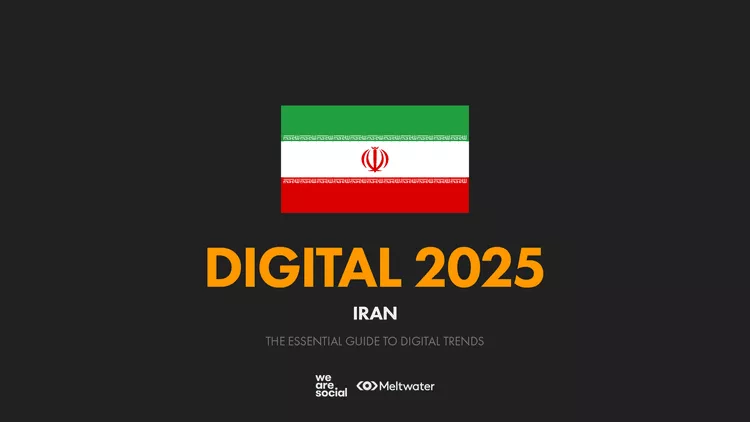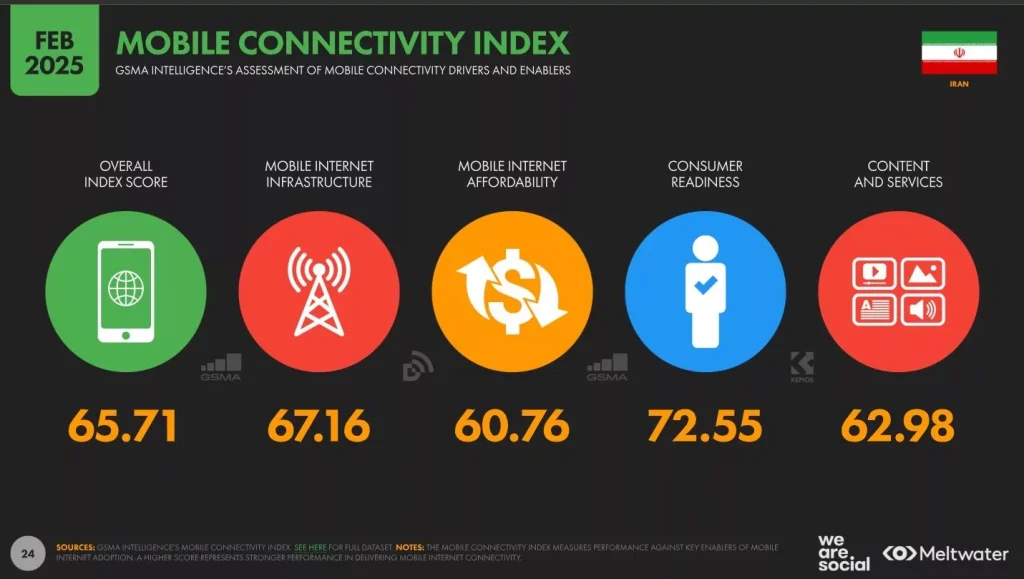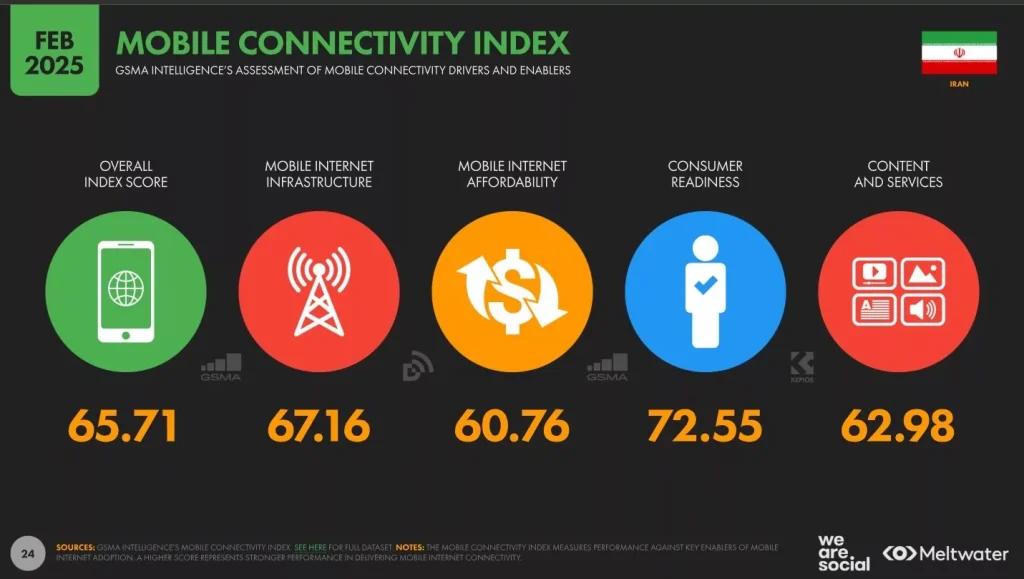
Iran’s Online Environment As of DataReportal: 20% of the Population Still Offline
The DataReportal report Digital 2025: Iran employs data analytics platform DataReportal to examine various metrics like mobile subscriptions, internet penetration, and social media use based on reliable, most recent available data to provide an overview of Iran's digital situation in 2025.
The DataReportal report Digital 2025: Iran employs data analytics platform DataReportal to examine various metrics like mobile subscriptions, internet penetration, and social media use based on reliable, most recent available data to provide an overview of Iran's digital situation in 2025. Despite the statistics indicating increasing internet and social media usage among Iranians, issues like the digital divide, cybersecurity, and the quality of internet access remain significant concerns.
Iran Digital 2025: Key Statistics at a Glance
Iran had 152 million mobile subscriptions at the start of 2025, with a 166% penetration rate, according to DataReportal. However, some of these subscriptions could be voice and SMS but not internet.
During the same period, internet users in Iran were 73.2 million, with an internet penetration rate of 79.6%.
Also, as of January 2025, there were 48 million social media accounts in Iran, representing 52.2% of the population of the country.
The above numbers provide a rough overview of Iran's digital landscape in early 2025, but the information has to be dug deeper into in order to understand the overall picture of evolving trends and digital behavior.
Next, let us consider the numbers provided in the report in detail.
Iran's Population in 2025
As of January 2025, Iran had a population of 92 million. Figures show that between early 2024 and the start of 2025, the population had grown by 906,000 (a 1% growth). At the beginning of 2025, 77.9% of Iran's population lived in urban areas, and 22.1% lived in rural areas. During the same period, 49.2% of the population were female, and 50.8% were male.
At the beginning of 2025, Iran's median age was 34, so half the population was older and half younger than this. To clarify further, the population breakdown by age group was as follows:
6.4% aged 0–4
12.6% aged 5–12
7.3% aged 13–17
9.1% aged 18–24
14.7% aged 25–34
19.1% aged 35–44
13.2% aged 45–54
9.0% aged 55–64
8.6% aged 65+
Mobile Connections doesnt Mean Reliable Access

Iran had 152 million active mobile connections at the beginning of 2025, GSMA Intelligence reports. To put this into context, most people use more than one SIM card, and therefore the number of mobile connections is much higher than the population. Indeed, GSMA statistics show that in January 2025, mobile connections in Iran represented 166% of the population.
But large numbers of connections do not necessarily equate to quality or equitable access. Data indicate that 93.1% of Iran's mobile connections are broadband (over 3G, 4G, or 5G networks). But not all devices on mobile broadband always use cellular data. For example, some plans provide voice calls and SMS services only, so this figure cannot be converted into actual mobile internet usage.
One-Fifth of Population Remain Offline

The most recent figures available at the time of this report show that, as of January 2025, there were 73.2 million internet users in Iran, equivalent to an internet penetration rate of 79.6% at the beginning of the year. Kepios analysis shows that, between January 2024 and January 2025, the number of internet users grew by 721,000 (1%). Internet adoption rate, however, was unchanged over the period.
These figures also show that 18.8 million people (20.4% of the population) were still offline from the internet at the beginning of 2025—a number roughly equivalent to Iran's rural population.
Given this situation, DataReportal explains that compiling and analyzing internet user data is highly complex, which means the latest available statistics are typically delayed by several months. As a result, current figures may not accurately capture present conditions, meaning real internet adoption and growth rates could potentially exceed what the data indicates.

The Speed Challenge: Progress, Yet Lagging Behind
Another important aspect in internet quality measurement is speed. According to Ookla data, Iran's mobile internet download speeds increased by 7.06 Mbps (22.2%) over the 12 months leading up to January 2025. Fixed broadband speeds increased by 3.27 Mbps (25.6%) over the same period.
Another important aspect in internet quality measurement is speed. According to Ookla data, Iran's mobile internet download speeds increased by 7.06 Mbps (22.2%) over the 12 months leading up to January 2025. Fixed broadband speeds increased by 3.27 Mbps (25.6%) over the same period.

Half of Population Engaging in Social Media
Iran had 48 million active social media accounts as of January 2025, according to DataReportal, which was equal to 52.2% of the country's total population in January of the same year. Even with DataReportal's attempts to eliminate duplicate users on multiple platforms and filter out bot accounts from its statistics, these may still be less than unique individual users.
Kepios' report shows that Iranian social media accounts were flat between early 2024 and early 2025. Given that this was also a period of population growth, it is a big question: How much have censorship and blocking prevented the population from reaching social sites?
The urban-rural digital divide is another significant challenge. While one-fifth of the Iranian population is not connected to the internet, that figure is a paltry 10% in neighboring countries like Turkey - highlighting enormous regional disparities in digital access.
Half of Population Engaging in Social Media
Iran had 48 million active social media accounts as of January 2025, according to DataReportal, which was equal to 52.2% of the country's total population in January of the same year. Even with DataReportal's attempts to eliminate duplicate users on multiple platforms and filter out bot accounts from its statistics, these may still be less than unique individual users.
Kepios' report shows that Iranian social media accounts were flat between early 2024 and early 2025. Given that this was also a period of population growth, it is a big question: How much have censorship and blocking prevented the population from reaching social sites?
The urban-rural digital divide is another significant challenge. While one-fifth of the Iranian population is not connected to the internet, that figure is a paltry 10% in neighboring countries like Turkey - highlighting enormous regional disparities in digital access.










